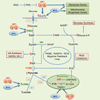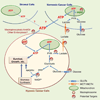The Warburg effect: evolving interpretations of an established concept
- PMID: 25277420
- PMCID: PMC4356994
- DOI: 10.1016/j.freeradbiomed.2014.08.027
The Warburg effect: evolving interpretations of an established concept
Abstract
Metabolic reprogramming and altered bioenergetics have emerged as hallmarks of cancer and an area of active basic and translational cancer research. Drastically upregulated glucose transport and metabolism in most cancers regardless of the oxygen supply, a phenomenon called the Warburg effect, is a major focuses of the research. Warburg speculated that cancer cells, due to defective mitochondrial oxidative phosphorylation (OXPHOS), switch to glycolysis for ATP synthesis, even in the presence of oxygen. Studies in the recent decade indicated that while glycolysis is indeed drastically upregulated in almost all cancer cells, mitochondrial respiration continues to operate normally at rates proportional to oxygen supply. There is no OXPHOS-to-glycolysis switch but rather upregulation of glycolysis. Furthermore, upregulated glycolysis appears to be for synthesis of biomass and reducing equivalents in addition to ATP production. The new finding that a significant amount of glycolytic intermediates is diverted to the pentose phosphate pathway (PPP) for production of NADPH has profound implications in how cancer cells use the Warburg effect to cope with reactive oxygen species (ROS) generation and oxidative stress, opening the door for anticancer interventions taking advantage of this. Recent findings in the Warburg effect and its relationship with ROS and oxidative stress controls will be reviewed. Cancer treatment strategies based on these new findings will be presented and discussed.
Keywords: Glucose transport; HIF; MYC; Metabolism reprogram; ROS; Warburg effect.
Published by Elsevier Inc.
Figures


 .
.References
-
- Cairns RA, Harris IS, Mak TW. Regulation of cancer cell metabolism. Nat Rev Cancer. 2011;11:85–95. - PubMed
-
- Kroemer G, Pouyssegur J. Tumor cell metabolism: cancer's Achilles' heel. Cancer Cell. 2008;13:472–482. - PubMed
-
- Levine AJ, Puzio-Kuter AM. The control of the metabolic switch in cancers by oncogenes and tumor suppressor genes. Science. 2010;330:1340–1344. - PubMed
-
- Schulze A, Harris AL. How cancer metabolism is tuned for proliferation and vulnerable to disruption. Nature. 2012;491:364–373. - PubMed
Publication types
MeSH terms
Substances
Grants and funding
LinkOut - more resources
Full Text Sources
Other Literature Sources

